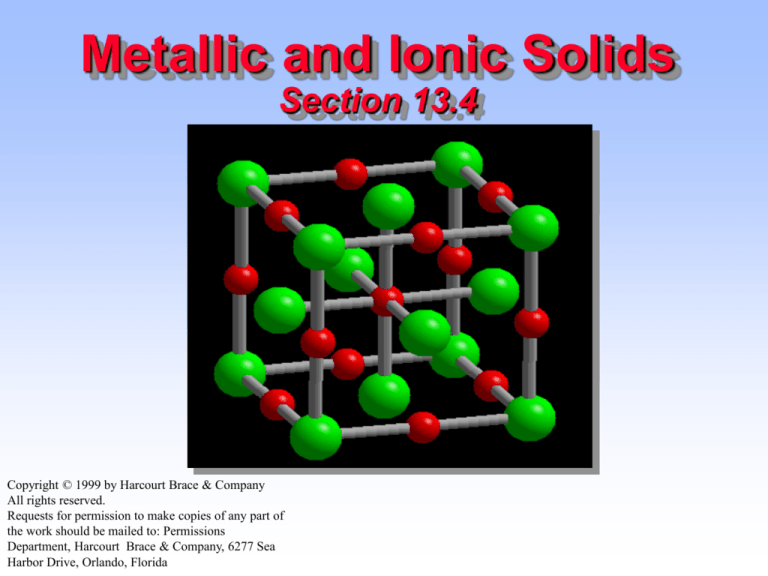
Metallic and Ionic Solids
Section 13.4
Copyright © 1999 by Harcourt Brace & Company
All rights reserved.
Requests for permission to make copies of any part of
the work should be mailed to: Permissions
Department, Harcourt Brace & Company, 6277 Sea
Harbor Drive, Orlando, Florida
Types of Solids
Table 13.6
TYPE
EXAMPLE
FORCE
Ionic
NaCl, CaF2, ZnS
Ion-ion
Metallic
Na, Fe
Metallic
Molecular Ice, I2
Dipole
Ind. dipole
Network
Extended
covalent
Diamond
Graphite
Copyright (c) 1999 by Harcourt Brace & Company
All rights reserved
Types of Solids
Type
Built from
Examples
Amorphous
Covalently bonded network with limited
ordering
Glass, plastics, polymers
Ionic
+ and – ions
NaCl, CsCl, (NH4)2SO4
Metallic
Atoms or metallic ions in sea of e-
Molecular
Molecules with internal covalent bonds, and
intramolcular attractions: dipole-dipole, Hbond, London dispersion
H 2 , ice, I2, CH30H
Network
Atoms held in network covalent bonds
Graphite, diamond, quartz
Copyright (c) 1999 by Harcourt Brace & Company
All rights reserved
Properties of Solids
1. Molecules, atoms or
ions locked into a
CRYSTAL
LATTICE
2. Particles are CLOSE
together
3. STRONG IM forces
4. Highly ordered, rigid,
incompressible
Copyright (c) 1999 by Harcourt Brace & Company
All rights reserved
ZnS, zinc sulfide
Crystal Lattices
Regular 3-D arrangements of equivalent
LATTICE POINTS in space.
The lattice points define UNIT CELLS, the
smallest repeating internal unit that has the
symmetry characteristic of the solid.
There are 7 basic crystal systems, but we are
only concerned with CUBIC.
Copyright (c) 1999 by Harcourt Brace & Company
All rights reserved
Cubic Unit Cells
All sides
equal length
All angles
are 90 degrees
Copyright (c) 1999 by Harcourt Brace & Company
All rights reserved
Cubic Unit Cells
Figure 13.28
Metals have unit cells that are
• simple cubic (SC)
• body centered cubic (BCC)
• face centered cubic (FCC)
Copyright (c) 1999 by Harcourt Brace & Company
All rights reserved
Simple Cubic Unit Cell
Figure 13.28
• Simple cubic unit cell.
• Note that each atom is at a corner of a
unit cell and is shared among 8 unit
cells.
Copyright (c) 1999 by Harcourt Brace & Company
All rights reserved
Body-Centered Cubic Unit Cell
Copyright (c) 1999 by Harcourt Brace & Company
All rights reserved
Body Centered Cubic
Unit Cell
• Has 8 identical atoms or ions at the corners
and additional particle at the center of the
cube
• Total of two particles in the unit cell
• Ex: alkali metals, iron, K, Na, Ba, Ce, Li, V
Copyright (c) 1999 by Harcourt Brace & Company
All rights reserved
Face Centered Cubic
Unit Cell
Copyright (c) 1999 by Harcourt Brace & Company
All rights reserved
Face Centered Cubic
Unit Cell
• There is a particle in each of the six faces
of the cube in addition to the those at the
corners
• Each particle in the face of the cube is
shared equally between two unit cells (1/2
of particle is within unit cell)
• 4 atoms/ions within the unit cell
Copyright (c) 1999 by Harcourt Brace & Company
All rights reserved
Crystal Lattices—Packing
of Atoms or Ions
Assume atoms are
hard spheres and
that crystals are
built by PACKING
of these spheres
as efficiently as
possible.
FCC is more
efficient than
either BC or SC.
Copyright (c) 1999 by Harcourt Brace & Company
All rights reserved
See Closer Look, pp. 622-623
Crystal Lattices—Packing
of Atoms or Ions
Packing of C60
molecules. They
are arranged at
the lattice points
of a FCC lattice.
Copyright (c) 1999 by Harcourt Brace & Company
All rights reserved
Crystal Lattices and Unit Cells
Unit Cell is the smallest repeating unit
that retains the symmetry properties of
the Lattice
Cubic Cells
Copyright (c) 1999 by Harcourt Brace & Company
All rights reserved
An Atom in this corner is
shared by eight unit cells
sc
Copyright (c) 1999 by Harcourt Brace & Company
All rights reserved
fcc
bcc
The cubic crystal lattices
are of three types
1. simple cubic (sc) 8 x 1/8 atom per
corner = one atom per cell
2. body-centered cubic (bcc) 8 x 1/8
atoms per corner + one atom in
center = 2 atoms / cell
3. face-centered cubic (fcc) 8 x 1/8 atom
/ corner + ½ atom per side x 6 sides
= 4 atoms per cell
Copyright (c) 1999 by Harcourt Brace & Company
All rights reserved
Density can be used to find
atomic radius if type of crystal is
known.
For fcc
2 x cell edge
e2 + e2 = l 2
l 2 = 2e2
l = 2 e
l = four atom radii
Volume of cell =
e3
Copyright (c) 1999 by Harcourt Brace & Company
All rights reserved
d = m /V
• density of metal = mass of cell/ Volume
• Mass of cell is mass of four atoms of metal
• Mass of cell =
atom mass / mol x 1mol/ 6.022 x1023
atoms x 4 atom/cell
Example: the density of Al is 2.699 g/cm3 the
Volume of a unit cell is 6.640 x 10-23 cm3 and the
atomic radius is then 143 pm
l = 2 e
l = four atom radii
Volume of cell = e3
Copyright (c) 1999 by Harcourt Brace & Company
All rights reserved
For Iron which has a bcc unit cell the
calculation is a little different
The Density of Iron is 7.8470 g/cm3
2 e
Copyright (c) 1999 by Harcourt Brace & Company
All rights reserved
D2 = (2 e)2+ e2
= 3e2
D = 3 e
D
e
D2 = (2
e)2+ e2
=
3e2
D = 3 e
2 e
There are two atoms per unit
cell Volume of cell = e3
e = D/3
V = e3= m/density
D=4xr
m = 2 x 55.85 g/6.022 x 1023 atoms
atom mass of Fe = 55.85
g/mol
e3 = 1.85 x 10-22/ 7.8470 g/cm3
-8 cm
e
=
2.87
x
10
Copyright (c) 1999 by Harcourt Brace & Company
All rights reserved
This gives cell edge of 287
pm and r = 124 pm
Finding the Lattice Type
To find out if a metal is SC, BCC or FCC, use
the known radius and density of an atom to
calc. no. of atoms per unit cell.
PROBLEM Al has density = 2.699 g/cm3 and
Al radius = 143 pm. Verify that Al is FCC.
SOLUTION
1.
Calc. unit cell volume
Copyright (c) 1999 by Harcourt Brace & Company
All rights reserved
Finding the Lattice Type
PROBLEM Al has density = 2.699 g/cm3 and Al radius = 143
pm. Verify that Al is FCC.
SOLUTION
1. Calc. unit cell volume
V = (cell edge)3
Edge distance comes from face diagonal.
Diagonal distance = 2 • edge
Copyright (c) 1999 by Harcourt Brace & Company
All rights reserved
Finding the Lattice Type
PROBLEM Al has density = 2.699 g/cm3 and Al radius = 143 pm.
Verify that Al is FCC.
SOLUTION
V = (cell edge)3 and face diagonal = 2 • edge
(Diagonal)2 = 2 (edge)2
Therefore,
Diag = 2 • (edge)
Copyright (c) 1999 by Harcourt Brace & Company
All rights reserved
Finding the Lattice Type
PROBLEM Al has density = 2.699 g/cm3 and Al radius = 143
pm. Verify that Al is FCC.
SOLUTION
Here diagonal = 4 • radius of Al = 572 pm
Therefore, edge = 572 pm / 2 = 404 pm
In centimeters, edge = 4.04 x 10-8 cm
So, V of unit cell = (4.04 x 10-8 cm)3
V = 6.62 x 10-23 cm3
Copyright (c) 1999 by Harcourt Brace & Company
All rights reserved
Finding the Lattice Type
PROBLEM Al has density = 2.699 g/cm3 and Al radius = 143
pm. Verify that Al is FCC.
SOLUTION
2.
Use V and density to calc. mass of unit
cell from DENS = MASS / VOL
Mass = density • volume
= (6.62 x 10-23 cm3)(2.699 g/cm3)
= 1.79 x 10-22 g/unit cell
Copyright (c) 1999 by Harcourt Brace & Company
All rights reserved
Finding the Lattice Type
PROBLEM Al has density = 2.699 g/cm3 and Al radius = 143
pm. Verify that Al is FCC.
SOLUTION
3. Calculate number of Al per unit cell from
mass of unit cell.
Copyright (c) 1999 by Harcourt Brace & Company
All rights reserved
Finding the Lattice Type
PROBLEM Al has density = 2.699 g/cm3 and Al radius = 143
pm. Verify that Al is FCC.
SOLUTION
3. Calculate number of Al per unit cell from
mass of unit cell.
26.98 g
1 mol
Mass 1 Al atom =
•
mol
6.022 x 1023 atoms
1 atom = 4.480 x 10-23 g, so
Copyright (c) 1999 by Harcourt Brace & Company
All rights reserved
Finding the Lattice Type
PROBLEM Al has density = 2.699 g/cm3 and Al radius = 143
pm. Verify that Al is FCC.
SOLUTION
3. Calculate number of Al per unit cell from
mass of unit cell.
26.98 g
1 mol
Mass 1 Al atom =
•
mol
6.022 x 1023 atoms
1 atom = 4.480 x 10-23 g, so
1.79 x 10-22 g
1 atom
•
= 3.99 Al atoms/unit cell
-23
unit cell
4.480 x 10
g
Copyright (c) 1999 by Harcourt Brace & Company
All rights reserved
Number of Atoms per Unit Cell
How can there be 4 atoms in
a unit cell?
1. Each corner Al is 1/8
inside the unit cell.
8 corners (1/8 Al per
corner) = 1 net Al
2. Each face Al is 1/2 inside
the cell
6 faces (1/2 per face) = 3
net Al’s
Copyright (c) 1999 by Harcourt Brace & Company
All rights reserved
Number of Atoms per Unit Cell
Unit Cell Type
Net Number Atoms
FCC
4
SC
1
BCC
2
Copyright (c) 1999 by Harcourt Brace & Company
All rights reserved
Simple Ionic Compounds
Lattices of many simple ionic solids are built
by taking a SC or FCC lattice of ions of one
type and placing ions of opposite charge in
the holes in the lattice.
EXAMPLE: CsCl has a SC lattice of Cs+ ions
with Cl- in the center.
Copyright (c) 1999 by Harcourt Brace & Company
All rights reserved
Simple Ionic Compounds
CsCl has a SC lattice of
Cs+ ions with Cl- in the
center.
1 unit cell has 1 Cl- ion
plus
(8 corners)(1/8 Cs+ per
corner)
= 1 net Cs+ ion.
Copyright (c) 1999 by Harcourt Brace & Company
All rights reserved
Simple Ionic Compounds
Salts with formula
MX can have SC
structure — but
not salts with
formula MX2 or
M2X
Copyright (c) 1999 by Harcourt Brace & Company
All rights reserved
Simple Ionic Compounds
Many common salts have FCC arrangements
of anions with cations in OCTAHEDRAL
HOLES — e.g., salts such as CA = NaCl
• FCC lattice of anions ----> 4 A-/unit cell
• C+ in octahedral holes ---> 1 C+ at center
+ [12 edges • 1/4 C+ per edge]
= 4 C+ per unit cell
Copyright (c) 1999 by Harcourt Brace & Company
All rights reserved
Construction of NaCl
We begin with a cube of Cl- ions. Add more Cl- ions in
the cube faces, and then add Na+ ion in the octahedral
holes.
Copyright (c) 1999 by Harcourt Brace & Company
All rights reserved
The Sodium Chloride Lattice
Na+ ions are in
OCTAHEDRAL holes
in a face-centered
cubic lattice of Clions.
Copyright (c) 1999 by Harcourt Brace & Company
All rights reserved
Copyright (c) 1999 by Harcourt Brace & Company
All rights reserved
Comparing NaCl and CsCl
• Even though their formulas have one
cation and one anion, the lattices of
CsCl and NaCl are different.
• The different lattices arise from the fact
that a Cs+ ion is much larger than a Na+
ion.
Copyright (c) 1999 by Harcourt Brace & Company
All rights reserved
Common Ionic Solids
Titanium dioxide,
TiO2
There are 2 net
Ti4+ ions and 4
net O2- ions per
unit cell.
Copyright (c) 1999 by Harcourt Brace & Company
All rights reserved
Common Ionic Solids
• Zinc sulfide, ZnS
• The S2- ions are in
TETRAHEDRAL
holes in the Zn2+
FCC lattice.
• This gives 4 net
Zn2+ ions and 4
net S2- ions.
Copyright (c) 1999 by Harcourt Brace & Company
All rights reserved
Common Ionic Solids
• Fluorite or CaF2
• FCC lattice of Ca2+
ions
• This gives 4 net
Ca2+ ions.
• F- ions in all 8
tetrahedral holes.
• This gives 8 net Fions.
Copyright (c) 1999 by Harcourt Brace & Company
All rights reserved
Summary Ionic Solids
• Compounds with formula MX are commonly
either sc or fcc
• Many salts have NaCl structure (fcc)
especially alkali metals
• Exceptions are CsCl, CsBr, CsI, alkaline
oxides and sulfides, and oxides of 4th row
transition metals (MO)
• Formulas can always be found from unit
cell structure
Copyright (c) 1999 by Harcourt Brace & Company
All rights reserved
Types of Solids
Table 13.6
TYPE
EXAMPLE
FORCE
Ionic
NaCl, CaF2, ZnS
Ion-ion
Metallic
Na, Fe
Metallic
Molecular Ice, I2
Dipole
Ind. dipole
Network
Extended
covalent
Diamond
Graphite
Copyright (c) 1999 by Harcourt Brace & Company
All rights reserved
Molecular Solids
• Covalently bonded molecules
• Arrangement depends on shape of
molecules and types of IM forces
• Ex: Ice molecules pack densely and
maximize their attraction
Copyright (c) 1999 by Harcourt Brace & Company
All rights reserved
Network Solids
• Covalently bonded atoms
• High mp’s and bp’s, hard, rigid, and high
energy required to break bonds
• Ex: graphite, diamond, elemental silicon,
silica
• Silicon exists in diamond structure
• Silicates – made of silicon and oxygen (ex:
sand, talc, quartz)
Copyright (c) 1999 by Harcourt Brace & Company
All rights reserved
Network Solids
Diamond
Graphite
Copyright (c) 1999 by Harcourt Brace & Company
All rights reserved
Network Solids
A comparison of diamond (pure carbon)
with silicon.
Copyright (c) 1999 by Harcourt Brace & Company
All rights reserved
Amorphous Solids
• Properties
–Solid lacks regular structures
–Has a melting range
–Restrictive movement of molecules
–Unable to identify unit cell in solid phase
–Breaks in random pieces
• Examples: glass, polymers, nylon
Copyright (c) 1999 by Harcourt Brace & Company
All rights reserved
Properties of Solids
• Melting point – the crystal lattice of a solid
breaks converting to a liquid
• Enthalpy of fusion – energy needed to
convert one mole from sl
– increase in with increasing MW due to strength
of IM forces
– Increase in ionic compounds due to increase in
lattice energy (depends on size and charge)
• Sublimation – conversion of a solid to a
gas
Copyright (c) 1999 by Harcourt Brace & Company
All rights reserved








